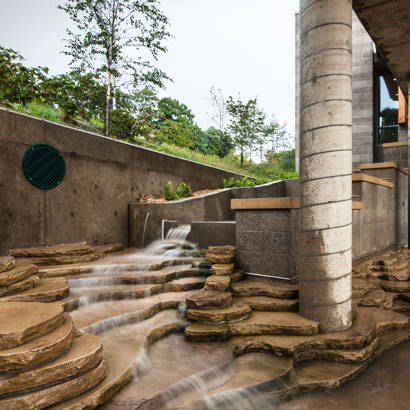
As traditional gray stormwater management infrastructure continues to age, it often fails to adequately mitigate effects from increasingly frequent extreme weather events, as well as everyday rain events. Severe flooding and degraded water quality from combined sewer overflows ensue, and can lead to poor environmental and community health, negatively impacting the quality of life for surrounding residents. Not surprisingly, such circumstances disproportionately affect the most vulnerable communities, including low income and communities of color.
These realities helped to shape the creation of NRPA’s Great Urban Parks Campaign, which aims to promote and advance green infrastructure stormwater management projects in parks that are working to address equity. The campaign specifically highlights the multiple benefits these projects can bring to surrounding communities, including improved community health, access to green space and nature, and opportunities for education and employment. Meaningful and ongoing community engagement and a collaborative approach with a multistakeholder group are essential to realizing these benefits and ensuring that green stormwater infrastructure projects in parks are embraced by nearby residents.
Over the past two years, in four urban communities across the country, large- scale green infrastructure projects in parks have commenced as part of NRPA’s Great Urban Parks Campaign initiative. Slated to finish by late fall 2018, these projects have served as case studies highlighting the best practices and sometime missteps of creating multiple-benefit green stormwater infrastructure projects in parks. Their community engagement experiences demonstrate the value and challenges associated with meaningful community engagement and how such engagement can benefit the overall project. Through this initiative, NRPA has learned some valuable lessons in successfully collaborating with communities on green infrastructure projects.
Cast a Wide Net
From the earliest design and planning phases, it is critical for green stormwater infrastructure projects to be seen by all stakeholders as a continuing partnership. Park agencies must cast a wide net from the outset and collaborate with a diverse set of traditional partners (such as water utilities, environmental nonprofits and watershed associations), as well as less thought of partners (such as local housing authorities, schools and health care centers). This silo-busting approach adds to the overall success and impact of green infrastructure projects and contributes to higher-performing public spaces.
In Baltimore, Great Urban Park Campaign (GUPC) partners looked to The 6th Branch, a returning veterans service organization, to take on weekly site maintenance that the city could not provide. The 6th Branch now conducts regularly scheduled cleanup days, while Rebuild Johnston Square, a local neighborhood organization, also plans biweekly cleanup and planting days to foster stewardship and community involvement.
Rely on Community Expertise
Allow local residents to lend their skills, knowledge and insights to the project efforts. After all, no one knows a community better than those who live in it. Carve out elements of the larger project specific to local partners and residents, and make sure those partners are given proper credit. This ensures that the project will receive higher public profile and community acceptance.
Local residents will also be able to educate you on the community’s history and past experiences. These facts may help to inform your engagement strategy and raise awareness to sensitives that may exist within a community. For instance, local GUPC partners in both Pittsburgh and Baltimore expressed concern over a proposed civic engagement survey to measure how park improvement projects affect residents’ attitudes toward local government. They explained that many underserved communities are historically “over-surveyed, over-promised and under delivered,” and, as a result, local residents tend to be skeptical about proposed community projects. Sensitivities to these issues and histories can be critical in the project’s success.
Connect to Existing Efforts
Do not assume that the community will come to you to offer input and knowledge. It is import that your engagement efforts look to already planned events and other existing community infrastructure as a way to connect and share information. The public participation process must take place on the community’s terms, not on the Monday to Friday workday schedules of the project managers. This may mean hosting booths at neighborhood festivals, attending local church gatherings and weekend events. Community engagement can also be enhanced when social, recreational or celebratory events are held at the project site for community members, project partners and investors.
Be Willing to Let Go of Expectations
The ability to listen, be adaptive, reevaluate and work together develops true community-inspired visions. In Atlanta, partners received pushback from the community on initial project designs. Their redesign took the community’s desires fully into consideration by removing a large pond from the plan. Community members felt the pond would be a magnet for trash, and some feared for the safety of children and youth. The eventual vision was substantially different than what was envisioned at the start. It required flexibility and willingness to go back to the drawing board to incorporate community feedback.
Community Collaboration Isn’t Easy or Quick
“Early, often and sometimes messy” is a motto often expressed when it comes to community collaboration. Meaningful community engagement takes time, and it’s important for project teams to stay adaptive and flexible, even if this means that timelines might change. Projects that offer opportunities for the community to engage in regular project visioning and planning reach goals more smoothly and gain much higher community acceptance and ownership.
According to the EPA’s Green Infrastructure in Parks: A Guide to Collaboration, Funding and Community Engagement: “When community members come together to correct environmental damage or to rehabilitate and redesign parks, they are able to actively participate in the decision-making process and gain a voice in improving the local environment and community livability.”
Thanks to ongoing support from Southwest Airlines, NRPA continues to identify best practices and innovative strategies that effectively empower the community to influence the design of a green infrastructure project as part of the Great Urban Parks Campaign. Stay tuned for additional lessons learned and updates from our community partners through fall 2017.
Lori Robertson is NRPA’s Director of Conservation.

